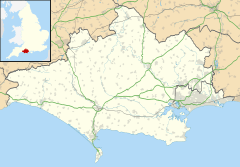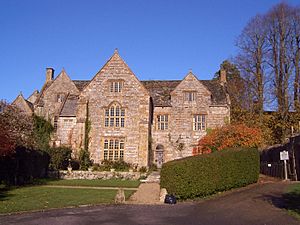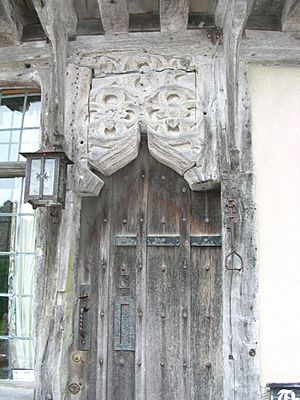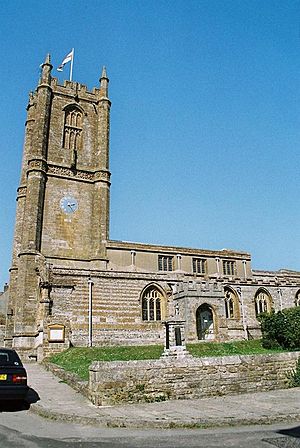Cerne Abbas facts for kids
Quick facts for kids Cerne Abbas |
|
|---|---|
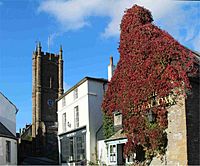 The village centre |
|
| Population | 820 |
| OS grid reference | ST662012 |
| • London | 112.5 miles |
| Unitary authority |
|
| Ceremonial county | |
| Region | |
| Country | England |
| Sovereign state | United Kingdom |
| Post town | Dorchester |
| Postcode district | DT2 |
| Dialling code | 01300 |
| Police | Dorset |
| Fire | Dorset |
| Ambulance | South Western |
| EU Parliament | South West England |
| UK Parliament |
|
Cerne Abbas is a charming village in the county of Dorset, located in southern England. It sits in the beautiful Cerne Valley, which is part of the Dorset Downs. The village is about 10 kilometers (6 miles) north of Dorchester. In 2013, about 820 people lived in Cerne Abbas.
In 2008, a real estate company called Savills named Cerne Abbas "Britain's Most Desirable Village." This shows how special and appealing the village is!
Contents
History of Cerne Abbas
The village of Cerne Abbas grew up around a very important Benedictine abbey called Cerne Abbey. This abbey was founded way back in AD 987. The name "Abbas" comes from a Latin word meaning "abbot," who was the head of the abbey.
In 1086, a famous survey called the Domesday Book recorded that the area had lots of farmland. The abbey was very powerful for over 500 years. However, in 1539, King Henry VIII closed down many monasteries, including Cerne Abbey. This event was called the Dissolution of the Monasteries. Most of the abbey was destroyed, but parts of it, like the Abbot's Porch and a guesthouse, still remain. There's also St Augustine's Well, which people say was blessed by Saint Augustine.
The village church, St Mary's Church, was built by the abbey in the late 1200s. It's still in the heart of the village and has many of its original features.
Village Life After the Abbey
After the abbey closed, Cerne Abbas became a busy little market town. It was famous for its beer because of the excellent underground water. People bought Cerne Abbas beer as far away as London, and it was even sent to America! At one time, the village had 14 pubs and about 1,500 people living there.
The village also used water power for industries like milling, tanning leather, weaving silk, and making gloves and hats.
Changes in the 19th Century
When railways were built in the 1800s, they didn't come through Cerne Abbas. This caused the village to become less important. By 1906, the population had dropped by half, and many houses were in bad condition. In 1919, the village was sold by the Pitt-Rivers family, who had owned it for a long time.
Today, Cerne Abbas is a lovely village with a local school, a post office, three historic pubs, tearooms, and other shops.
Searching for the Abbey's Past
In 2023, archaeologists started digging in Cerne Abbas. They are hoping to find the long-lost ruins of Cerne Abbey and learn more about its history.
Fun Things to See in Cerne Abbas
Many visitors come to Cerne Abbas because of its beautiful river and old stone houses. They also come to see the Abbey ruins, the famous Giant, and various local events.
St Mary's Church is from the 13th century, but it was mostly rebuilt in the 1400s and early 1500s. It was partly fixed up again in the 1600s. Inside, you can see a pulpit from the 1600s and a large east window that probably came from the old abbey.
The Cerne Abbas Giant
The most famous attraction in Cerne Abbas is the Giant. This is a huge, 55-meter (180-foot) tall figure carved into a chalk hillside. The Giant is owned by the National Trust.
People think the Giant might be an ancient Iron Age symbol of good luck and new life. However, we don't have any written records of the Giant before the 1600s. It's also unlikely that the monks of Cerne Abbey would have allowed such a figure to be near their holy place. Because of this, many experts believe the Giant was actually created in the mid-1600s. Still, there is evidence that Iron Age people lived on the nearby hills a very long time ago.
Village Events
Cerne Abbas hosts several fun events throughout the year:
- Cerne Abbas Open Gardens: Every June, many gardens in the village open to visitors. Over a thousand people come to see them!
- Horticultural Shows: These shows celebrate local plants and flowers.
- Annual Village Fete: A traditional village fair with games and activities.
- Cerne Abbas Music Festival: This four-day festival started in 1990. It brings famous classical musicians from all over the world to the village.
- Wessex Morris Men: This group often performs traditional Morris dances in the village on Bank Holidays.
Famous People from Cerne Abbas
Some interesting people have connections to Cerne Abbas:
- Joseph Clark (1834–1926), a painter, was born in the village.
- Joseph Benwell Clark (1857–1938), another artist, was also born here and later came back to live in Cerne Abbas.
- Kate Adie (born 1945), a well-known journalist, lives in Cerne Abbas.
Cerne Abbas in Books
Cerne Abbas has appeared in several books:
- The village is called "Abbots Cernel" in Thomas Hardy's famous Wessex novels.
- School of the Night, a mystery by Judith Cook, takes place in Elizabethan England and includes scenes set in Cerne Abbas. It also mentions the Giant.
- Unconquered, a historical novel by Neil Swanson, describes a character's childhood in Cerne Abbas.
- In John Le Carré's A Murder of Quality, a murder happens in a place called "Carne Abbas" in "Dorsett."
- Australian authors Kate Forsythe and Kim Wilkins wrote a book of short stories called The Silver Well in 2017. All the stories are set in Cerne Abbas and cover different times in the village's history, from AD 44 to 2017.
See also
 In Spanish: Cerne Abbas para niños
In Spanish: Cerne Abbas para niños


